Topgolf Callaway Brands Bundle
How Did Callaway Golf Transform into Topgolf Callaway Brands?
Topgolf Callaway Brands' story is a compelling narrative of strategic evolution in the sports and entertainment landscape. From its roots as Topgolf Callaway Brands SWOT Analysis, the company has undergone a remarkable transformation. This journey showcases how a traditional golf equipment manufacturer can successfully diversify and capture new market opportunities. Understanding this evolution is key to appreciating its current market position and future prospects.
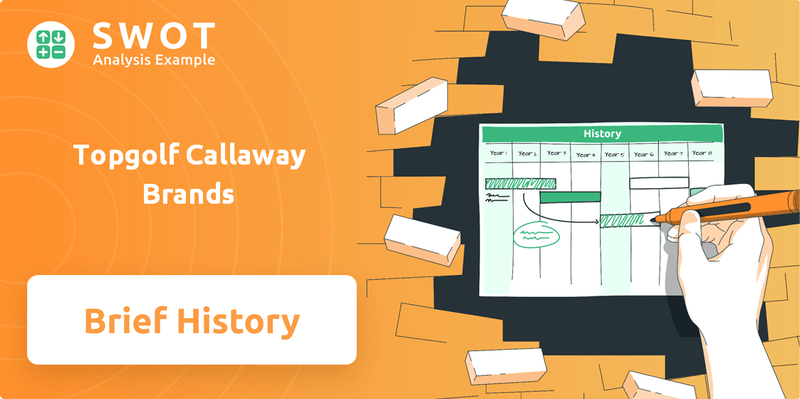
The acquisition of Topgolf in 2021 marked a pivotal moment, propelling Callaway Golf into the experiential entertainment sector. This strategic shift allowed the company to broaden its appeal, catering to both avid golfers and a wider audience seeking social and recreational activities. Exploring the Company History reveals the key decisions and innovations that have shaped Topgolf Callaway Brands into a global sports and entertainment powerhouse.
What is the Topgolf Callaway Brands Founding Story?
The story of Topgolf Callaway Brands begins with a visionary entrepreneur named Ely Callaway Jr. He launched Callaway Golf Company on January 29, 1982. Callaway's background in textiles and wine gave him a unique perspective on business and a passion for golf.
Callaway saw an opportunity to create golf clubs that were easier to use, particularly for amateur golfers. This led to the development of innovative products that would reshape the golf industry. The company's focus was on producing high-quality, innovative golf clubs using new materials and designs.
The company started with putters and wedges. The 'Big Bertha' driver, introduced in 1991, became a game-changer. The driver's larger size improved tee shots for many golfers, offering more forgiveness and distance. Callaway's name came from the founder's surname, reflecting his personal commitment to the brand. Early funding came from Callaway's own resources and investments from friends and family. The 1980s, with growing interest in recreational sports and technological advancements, provided a good environment for Callaway's innovative approach to golf equipment.
Callaway Golf was founded in 1982 by Ely Callaway Jr., focusing on innovative golf equipment. The 'Big Bertha' driver, launched in 1991, was a pivotal product.
- Ely Callaway Jr. founded Callaway Golf on January 29, 1982.
- The company initially produced putters and wedges.
- The 'Big Bertha' driver significantly boosted the company's growth.
- Callaway's initial funding came from his own resources and family.
The company's evolution continued with significant developments. The acquisition of Topgolf by Callaway in 2021 marked a major shift, merging golf equipment with sports entertainment. This merger created Topgolf Callaway Brands, expanding the company's reach and offerings. This strategic move combined Callaway's expertise in golf equipment with Topgolf's popular entertainment venues, creating a diversified business model. The merger was completed in March 2021, with Callaway Golf Company acquiring Topgolf Entertainment Group. In 2023, the company reported net revenue of approximately $4.28 billion, reflecting the combined strength of its golf equipment and entertainment divisions.
The merger of Callaway and Topgolf reshaped the landscape of the golf industry. The combined entity, Topgolf Callaway Brands, has expanded its market presence. As of early 2024, the company operates over 80 Topgolf venues globally, demonstrating its growth in the sports entertainment sector. A deeper dive into the Growth Strategy of Topgolf Callaway Brands reveals further details on its market strategies.
Topgolf Callaway Brands SWOT Analysis
- Complete SWOT Breakdown
- Fully Customizable
- Editable in Excel & Word
- Professional Formatting
- Investor-Ready Format
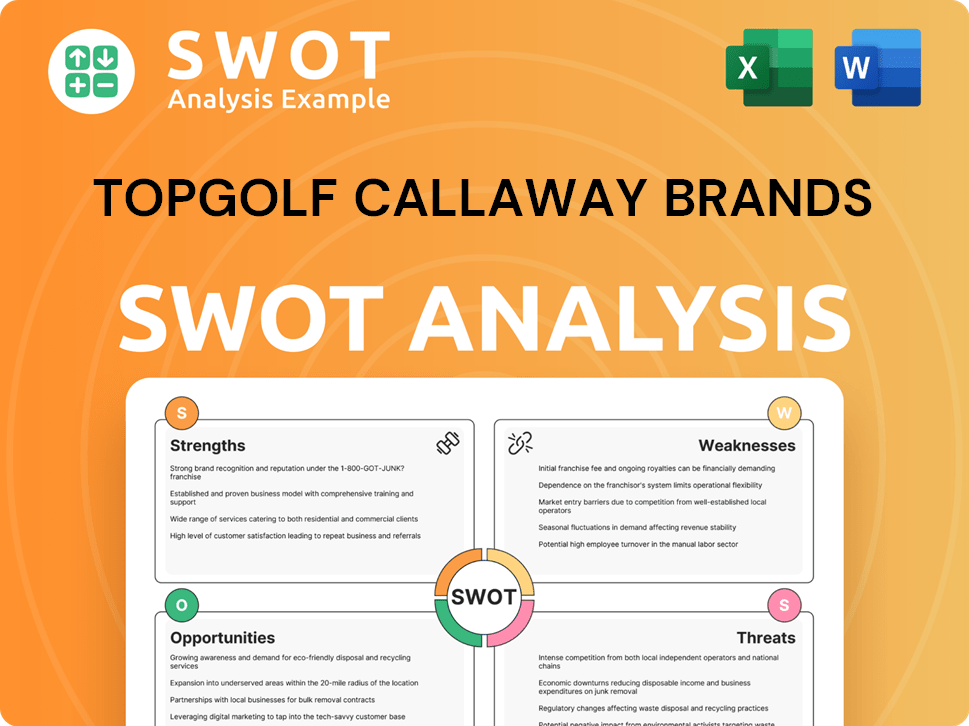
What Drove the Early Growth of Topgolf Callaway Brands?
The early years of Callaway Golf were marked by significant growth and strategic product innovations. The introduction of the Big Bertha driver in 1991 was a game-changer, propelling the company to new heights. This period also saw the company going public and expanding its reach globally. These early successes set the stage for the future of Topgolf Callaway Brands.
Callaway Golf's early success was fueled by innovative product launches. The Big Bertha driver, introduced in 1991, revolutionized the golf equipment industry. This innovation, along with subsequent products like the Great Big Bertha and ERC Fusion drivers, solidified Callaway's reputation for pushing technological boundaries in golf club design.
The company's expansion included entering new geographical markets to establish a global presence. In 1992, Callaway Golf went public, which provided capital for further growth. This strategic move allowed for increased investment in product development, marketing, and distribution, contributing to its market dominance.
Callaway focused on strong endorsements from professional golfers to build brand recognition. Superior product performance was also a key strategy. This approach helped to create a positive market reception, driving sales and establishing Callaway as a leading brand in the golf equipment market. As of 2024, the company continues to leverage these strategies.
Ely Callaway's leadership was a guiding force until his passing in 2001. The competitive landscape included well-established brands, but Callaway's consistent innovation and strong brand identity allowed it to emerge as a dominant force. This sustained growth laid the foundation for the company's future. For a more detailed look, you can read about the [Brief history of Topgolf Callaway Brands company](0).
Topgolf Callaway Brands PESTLE Analysis
- Covers All 6 PESTLE Categories
- No Research Needed – Save Hours of Work
- Built by Experts, Trusted by Consultants
- Instant Download, Ready to Use
- 100% Editable, Fully Customizable
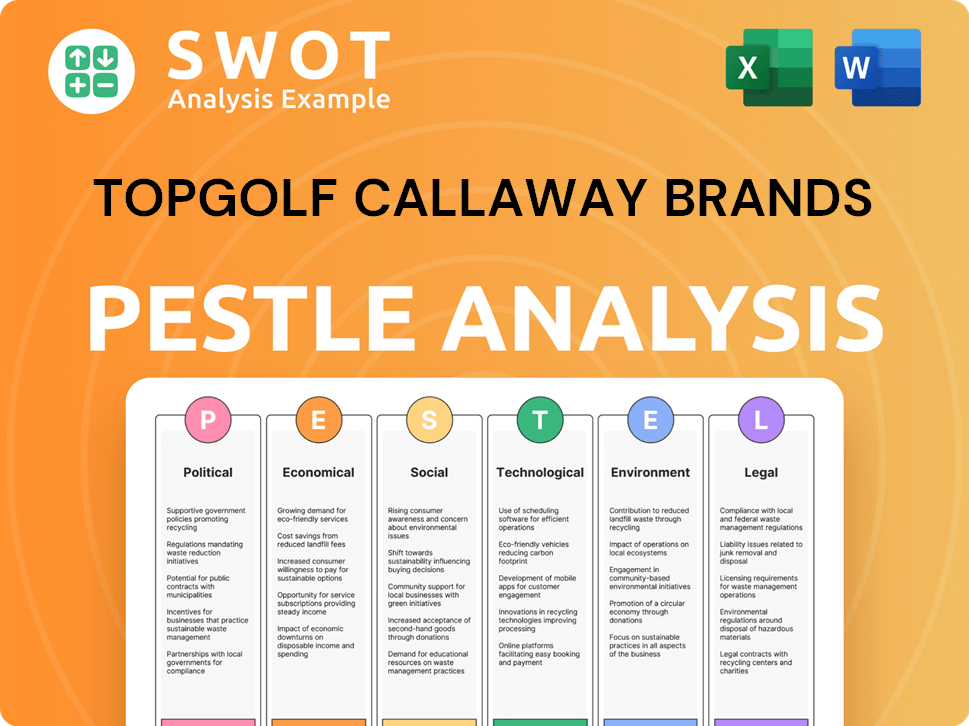
What are the key Milestones in Topgolf Callaway Brands history?
The Topgolf Callaway Brands has a rich history marked by significant achievements, evolving from a golf equipment manufacturer to a diversified sports and entertainment company. Key milestones include groundbreaking product launches, strategic partnerships, and a pivotal acquisition that reshaped its business model.
| Year | Milestone |
|---|---|
| 1991 | Callaway Golf introduced the Big Bertha driver, revolutionizing golf club design and performance. |
| 1990s-2000s | Callaway continued to innovate with products like the Great Big Bertha and ERC Fusion drivers, solidifying its position in the golf equipment market. |
| 2021 | Topgolf Callaway Brands acquired Topgolf, transforming the company into a diversified sports and entertainment entity. |
Callaway Golf has been at the forefront of innovation in golf equipment. The company has consistently introduced new technologies and designs to enhance player performance and experience.
The introduction of the Big Bertha driver in 1991 marked a turning point in golf club design, utilizing oversized clubheads and innovative materials. This innovation significantly improved the distance and forgiveness of golf clubs, setting a new standard in the industry.
Building on the success of Big Bertha, subsequent innovations like the Great Big Bertha and ERC Fusion drivers further advanced club technology. These products continued to push the boundaries of performance, enhancing Callaway's reputation for technological leadership.
Callaway Golf secured numerous patents for its clubhead designs and material compositions. These patents protected its innovative technologies and provided a competitive advantage in the golf equipment market.
Innovations in material composition played a crucial role in enhancing club performance. By experimenting with different materials, such as titanium and composite materials, Callaway Golf improved the durability and performance of its clubs.
The company has formed major partnerships with prominent golfers and industry organizations. These collaborations have been key to promoting the brand and expanding its reach in the golf market.
The acquisition of Topgolf in 2021 was a strategic move to diversify the business. This acquisition broadened the company's market reach beyond traditional golf enthusiasts.
Topgolf Callaway Brands has faced several challenges throughout its history, including market downturns and competitive pressures. The company has adapted through innovation and strategic shifts.
The global financial crisis impacted consumer spending on discretionary items like golf equipment. Economic fluctuations have posed challenges to sales and profitability in the golf industry.
Competition from other major golf brands has necessitated continuous innovation and strategic differentiation. The company must consistently develop superior products to maintain its market position.
The golf equipment industry requires continuous innovation to meet evolving player preferences. Developing products that resonate with golfers is a constant challenge, as technological limitations and market demands change.
Integrating Topgolf presented challenges, including managing a different business model focused on hospitality and entertainment venues. This transition required adapting to a new market segment.
Consumer preferences and habits are constantly evolving, requiring the company to adapt its products and services. The shift towards experiential entertainment has influenced Topgolf Callaway Brands' strategies.
Topgolf Callaway Brands' financial performance is subject to market conditions and consumer spending. The company's success depends on its ability to innovate, adapt, and effectively manage its diverse business segments.
The acquisition of Topgolf in 2021 was a strategic move that transformed Topgolf Callaway Brands. This shift broadened its market reach and aligned the company with broader industry trends. For more insights into the company's business model, check out Revenue Streams & Business Model of Topgolf Callaway Brands.
Topgolf Callaway Brands Business Model Canvas
- Complete 9-Block Business Model Canvas
- Effortlessly Communicate Your Business Strategy
- Investor-Ready BMC Format
- 100% Editable and Customizable
- Clear and Structured Layout
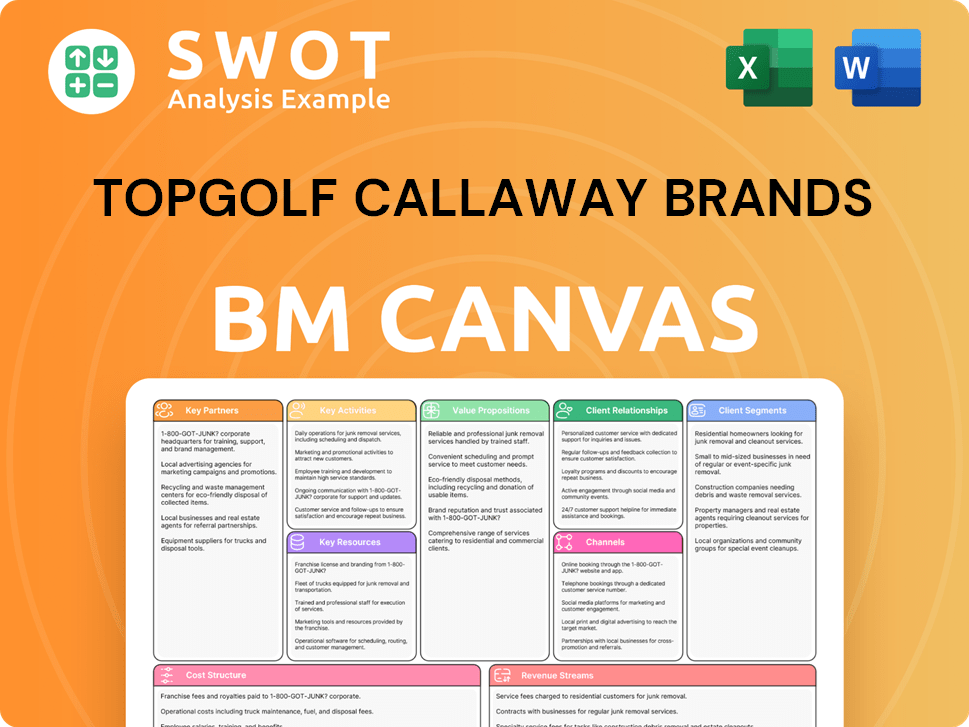
What is the Timeline of Key Events for Topgolf Callaway Brands?
The Topgolf Callaway Brands story is one of innovation and strategic expansion, evolving from a golf equipment manufacturer to a diversified sports and entertainment powerhouse. The Company History reveals a series of pivotal moments, from the introduction of groundbreaking golf clubs to the acquisition of lifestyle brands and the transformative merger with Topgolf, shaping its trajectory in the golf and entertainment industries.
| Year | Key Event |
|---|---|
| 1982 | Ely Callaway Jr. founded Callaway Golf Company. |
| 1991 | The revolutionary Big Bertha driver was introduced, changing the golf equipment landscape. |
| 1992 | Callaway Golf went public on the New York Stock Exchange. |
| 2001 | Founder Ely Callaway Jr. passed away. |
| 2005 | The Callaway Golf Company acquired the Top-Flite golf ball company. |
| 2012 | Callaway Golf acquired TravisMathew, a golf and lifestyle apparel brand. |
| 2016 | Callaway Golf made a significant investment in Topgolf. |
| 2017 | Callaway Golf acquired Ogio, a golf bag and accessories brand. |
| 2019 | Callaway Golf acquired Jack Wolfskin, an outdoor apparel and equipment brand. |
| 2021 | Callaway Golf completed the acquisition of Topgolf, becoming Topgolf Callaway Brands Corp. |
| 2023 | Topgolf Callaway Brands reported strong financial results, with net revenue increasing by 7% to $4.28 billion. |
| 2024 | The company continues to expand its Topgolf venues globally, with plans for new locations and technological enhancements. |
Topgolf Callaway Brands is focused on expanding its Topgolf entertainment venues worldwide. This includes opening new locations in key markets and enhancing existing venues with advanced technology. The company aims to capitalize on the growing demand for experiential entertainment and the popularity of the Topgolf brand. This expansion strategy is a core element of their growth plan, driving increased revenue and brand awareness.
The company is heavily investing in technological advancements within its Golf Equipment division. This includes research and development to create innovative clubs, balls, and accessories. The goal is to maintain a competitive edge in the market and to meet the evolving needs of golfers. These advancements are crucial for attracting and retaining customers, ensuring the continued success of Callaway Golf.
Topgolf Callaway Brands plans to further integrate its diverse brand portfolio, including TravisMathew, Jack Wolfskin, and Ogio. This integration aims to create synergies across the brands, maximizing cross-selling opportunities. This strategy enhances customer loyalty and brand value, supporting overall growth. The company aims to leverage each brand's strengths to drive collective success.
Analyst predictions suggest continued growth in both the Golf Equipment and experiential entertainment sectors. This diversified model positions Topgolf Callaway Brands to benefit from these trends. Leadership is committed to innovation, customer engagement, and sustainable growth, aiming to solidify its position as a leader. For more insights, check out the Marketing Strategy of Topgolf Callaway Brands.
Topgolf Callaway Brands Porter's Five Forces Analysis
- Covers All 5 Competitive Forces in Detail
- Structured for Consultants, Students, and Founders
- 100% Editable in Microsoft Word & Excel
- Instant Digital Download – Use Immediately
- Compatible with Mac & PC – Fully Unlocked
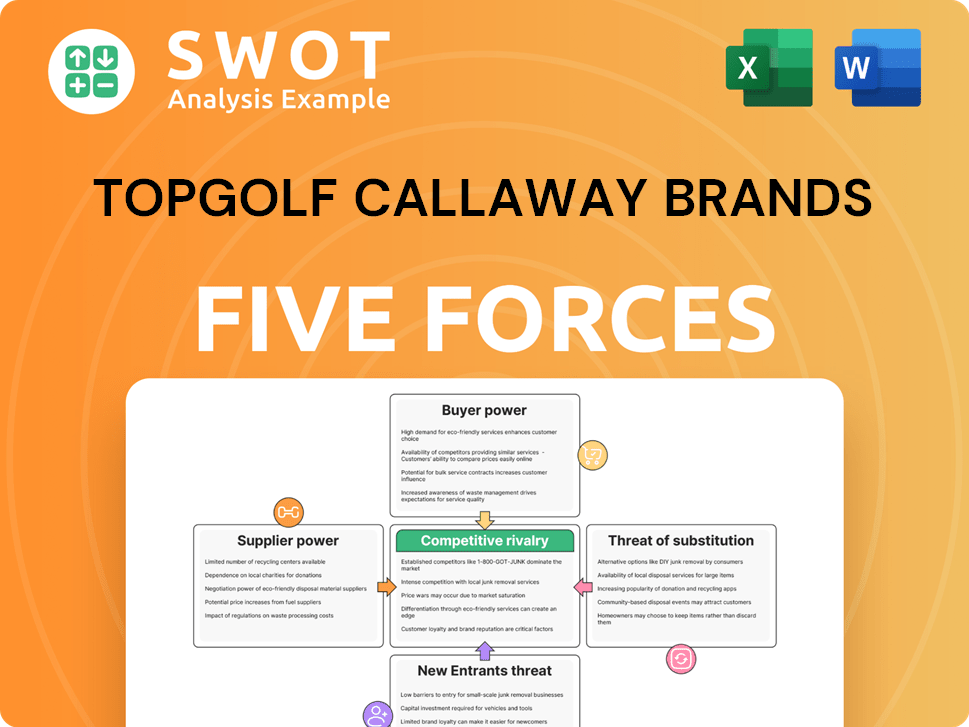
Related Blogs
- What is Competitive Landscape of Topgolf Callaway Brands Company?
- What is Growth Strategy and Future Prospects of Topgolf Callaway Brands Company?
- How Does Topgolf Callaway Brands Company Work?
- What is Sales and Marketing Strategy of Topgolf Callaway Brands Company?
- What is Brief History of Topgolf Callaway Brands Company?
- Who Owns Topgolf Callaway Brands Company?
- What is Customer Demographics and Target Market of Topgolf Callaway Brands Company?
Disclaimer
All information, articles, and product details provided on this website are for general informational and educational purposes only. We do not claim any ownership over, nor do we intend to infringe upon, any trademarks, copyrights, logos, brand names, or other intellectual property mentioned or depicted on this site. Such intellectual property remains the property of its respective owners, and any references here are made solely for identification or informational purposes, without implying any affiliation, endorsement, or partnership.
We make no representations or warranties, express or implied, regarding the accuracy, completeness, or suitability of any content or products presented. Nothing on this website should be construed as legal, tax, investment, financial, medical, or other professional advice. In addition, no part of this site—including articles or product references—constitutes a solicitation, recommendation, endorsement, advertisement, or offer to buy or sell any securities, franchises, or other financial instruments, particularly in jurisdictions where such activity would be unlawful.
All content is of a general nature and may not address the specific circumstances of any individual or entity. It is not a substitute for professional advice or services. Any actions you take based on the information provided here are strictly at your own risk. You accept full responsibility for any decisions or outcomes arising from your use of this website and agree to release us from any liability in connection with your use of, or reliance upon, the content or products found herein.